California LightWorks Interview with George Mekhtarian
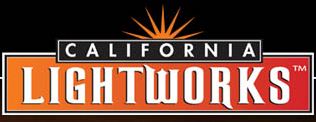
Recently I’ve had a lot of visitors asking me about California LightWorks’ lights (the SolarStorm and the SolarFlare). Today, I have the opportunity to ask George Mekhtarian, owner of California LightWorks, a few questions. A special thanks to George for participating in this interview.
Nate: George, tell us a little bit about yourself and your company. How in the world did you end up in the LED grow light industry?
George: Our industry is certainly unique, Nate. I mean, I didn’t exactly grow up dreaming about making LED grow lights one day.
I come from an Electrical Engineering background. I’ve always had a passion for automation and electrical circuits. I spent over 16 years working for Silicon Valley companies in the realm of semiconductor design and testing. Aside from my day job, I worked with my brother to start a manufacturing company based in Southern California circa 2000 called MWW. As you can imagine, manufacturing is a very difficult business in the United States given the competition from overseas. But we did manage to survive by constantly innovating and looking for opportunities where we can be competitive. A good part of MWW’s business today is sheet metal components for the US foodservice equipment industry.
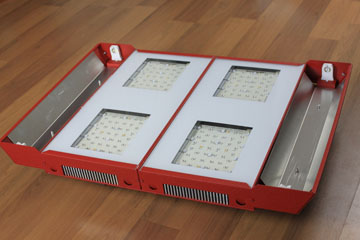
My brand new SolarStorm straight out of the box.
While MWW was slowly developing I was commuting to Silicon Valley every week. Being in the high tech world, I followed with intrigue the rapid advances in LED technology. Then in 2008, I was approached by some local growers in LA to see if I can put together some custom LED grow light fixtures for them. At the time UFO type lights were already in the market. So I studied the latest 3W diodes and after significant R&D, developed what became the XtremeLED grow light. A year later I was contracted by C.A.P. to start making the XtremeLED in volume. I decided to quit my day job, expand MWW and leverage the manufacturing infrastructure to make LED grow lights.
Of course we never stopped innovating. We noticed the need for high power grow lights and the new SolarFlare and SolarStorm products were born. After extensive testing, we realized that we had breakthrough products. So we decided to start California LightWorks and market our products directly to the growers.
Nate: Why did you decide to go with 5w diodes instead of the current favorite 3w diodes? For that matter, why not use 10w diodes or bigger?
George: Good question Nate. The wattage rating of LEDs is somewhat of a misnomer. The way we measure performance of a single die LED emitter is via current. The output light intensity of a LED is directly proportional to the current going through it. Most 1W LEDs are driven at 350 mA. 3W diodes are typically driven at 700 or 750 mA and 5W diodes can be driven at up to 1500 mA or more. One of the most important aspects of a LED is its packaging. Most of my competitors use LEDs packaged in China using low cost/low quality substrates that have a high thermal resistance. This means the LEDs have to be driven at a much lower current than their maximum rating in order to get good efficiency and long life. Many companies now claim they use US-made LED dies or chips but they don’t tell you that the dies are still packaged in the Far East.
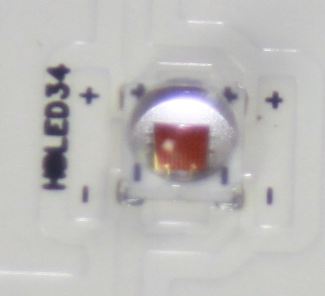
Here’s a close up on one of their five watt diodes.
Our LEDs come from a Silicon Valley company that uses the latest low thermal resistance ceramic packaging technology allowing us to drive our diodes at 1200 mA with excellent efficiency and life expectancy. This translates to high Photosynthetic Photon Flux (PPF) output for the end user with very good price/performance because we’re able to use fewer diodes. I would love to use 10W emitters but they don’t exist, at least not in a single die (chip) package yet. We have tested higher wattage (40+ watt) multi-die LED packages or what others refer to as “dense matrix” or “LED array” packages but we were not happy with their performance. Our field tests have shown that single die, high current LED emitters spread across a larger panel are the way to go.
Nate: What’s with the T8 UVB light? This is the first I’ve seen anything like this on an LED grow light.
George: Yes, that is a very unique feature on the SolarStorm. Research has shown that UV-B (280nm-315nm), an important part of the light spectrum available from the Sun outdoors, is essential for certain aspects of plant development. It’s correlated with improved potency of certain plants. For example, it has been shown that lettuce develops anti-oxidant rich violet spots when exposed to UVB. HID type lights emit very little or no UVB. LED grow lights emit zero UVB. For this reason, many growers revert to using supplemental fixtures to add UVB to their indoor gardens.
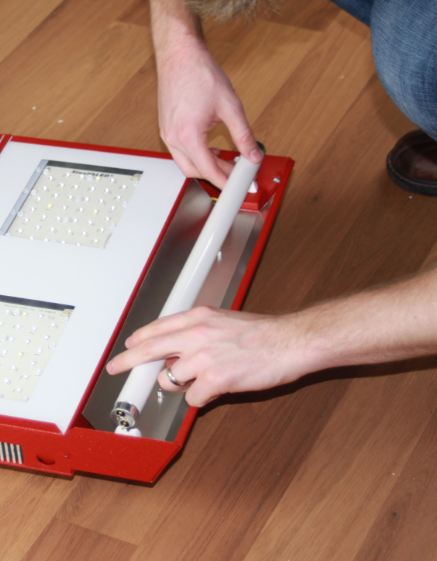
Some research indicates that UVB light enhances plant flowering.
With the SolarStorm, the UVB lights are built-in and they are already optimized with reflectors to cover the same footprint as the LEDs. So all the user has to do is flip the switch during the finishing phase of their grow cycle and they get the UVB to increase the potency of their crop.
Nate: Your website mentions that LEDs can’t really be used to produce UVB light. Could you explain why this is?
George: To be exact, we said LEDs cannot be used to produce UVB cost effectively. In our research we did find a few LED based solutions for UVB. With our T8 based solution, we can produce around 20 uW/cm2 of UVB from a 24” distance. To generate the same level of UVB with a LED based system would have increased the cost of the SolarStorm by 50%. The main reason we believe LED based UVB diodes are so expensive is because they are used for very special applications and are not mass produced yet. Fluorescent based UVB lights have high volume applications in the tanning and the indoor desert reptile industries and are therefore much more affordable today.
Nate: Is there a trial period for your lights?
George: Yes, we have a standard 90 day no-questions-asked return policy on all our products. In addition, we started what we’re calling the SolarStorm Grower Feedback Program (GFP) in October of last year. When we launched our new line we understood that the LED grow light industry suffered from a bad reputation. Many companies before us had sold low quality products that overpromised and under-delivered. Given the high price tag, we figured the best way to convince growers that we had a solid product was by collecting and publishing feedback from their peers. With the SolarStorm GFP, we are selecting a limited number of qualified growers to test a SolarStorm unit and post their feedback on a public forum (ledgrowlightforum.com). These growers can return their units back to us after the test and get their full deposit back or if they decide to keep it, they get their SolarStorm for half price. We have a couple of dozen growers already signed up for the SolarStorm GFP. We expect to have a large number of grow journals online soon from this program showing the SolarStorm in action delivering actual results. Our goal is to have the most extensively tested and documented LED grow light in the marketplace. And we want this feedback to be as raw and as genuine as possible.
Nate: What would you say are the key elements for maintaining the life of an LED grow light? We know that heat sinks are important, but what else should LED grow light consumers be looking at? What is California LightWorks doing in order to increase the life of its lights? Talk to us a little about your heat sinks.
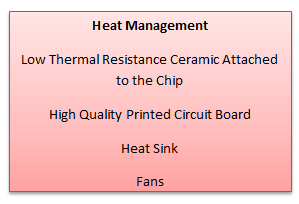 George: By far the most important criterion for maintaining the long life of LEDs is what’s called the junction temperature. That’s the temperature of the junction between the LED die (chip) and the substrate. As I mentioned before, the first thing we did is choose LEDs that have high quality packaging with low thermal resistance ceramic substrates. No matter how good the rest of your system, if your LED package is low quality, the junction temperature will go up causing lower efficiency and shorter lifespan. Next is the PCB. It essential to use a high-quality Metal Core PCB (MCPCB). This again helps keep the junction temperature down. Our MCPCBs are custom-made in the USA by one of the best companies in the business. And then finally you have the active thermal management system which typically consists of the heat sink and the fan(s). With fans it’s extremely important to have optimized air flow through the heat sink and minimize turbulence. We engineered out heat sinks with the latest computer aided design software to ensure optimized air flow and maximum effectiveness. Our heat sinks are heavy to ensure proper thermal distribution and are custom extruded for us in the USA.
George: By far the most important criterion for maintaining the long life of LEDs is what’s called the junction temperature. That’s the temperature of the junction between the LED die (chip) and the substrate. As I mentioned before, the first thing we did is choose LEDs that have high quality packaging with low thermal resistance ceramic substrates. No matter how good the rest of your system, if your LED package is low quality, the junction temperature will go up causing lower efficiency and shorter lifespan. Next is the PCB. It essential to use a high-quality Metal Core PCB (MCPCB). This again helps keep the junction temperature down. Our MCPCBs are custom-made in the USA by one of the best companies in the business. And then finally you have the active thermal management system which typically consists of the heat sink and the fan(s). With fans it’s extremely important to have optimized air flow through the heat sink and minimize turbulence. We engineered out heat sinks with the latest computer aided design software to ensure optimized air flow and maximum effectiveness. Our heat sinks are heavy to ensure proper thermal distribution and are custom extruded for us in the USA.
Aside from the junction temperature, the other thing that affects LED lifespan is environmental protection. Here again the LED packaging makes all the difference. Our LEDs have integrated glass primary optics and are rated JEDEC Level 1 (the highest level) for moisture sensitivity protection. In addition our enclosures have additional environmental protection for the drivers and the LEDs.
Nate: Talk to us a little bit about pricing. What’s driving the price of LED grow lights? When can consumers expect to see noticeable drops in the prices of these lights?
George: I would say that the LED diodes are the most expensive part of any LED grow light fixture. That’s why you see so many lower priced LED grow lights using low quality diodes. But the good news for the end user is that the price of high quality LED diodes is coming down. In the semiconductor world the axiom often used is Moore’s Law which states that performance doubles (or price for the same performance is cut in half) every 1.5-2 years. We’re not quite there yet with LEDs. But as production capacity for LEDs goes up around the world, I expect prices to come down. To give you an example, one LED company that we talked to grew their capacity from 200 million LEDs/yr to 1 billion LEDs/yr (a 5 fold increase) in the past year. This type of volume ramp-up has to lower prices in the near future.
The rest of the LED grow light system comes from mature industries (fans, aluminum, sheet metal, power supply drivers etc..) so I don’t expect to see huge changes there. At California LightWorks, we designed and implemented very cost effective drivers and fixtures so we’re very well positioned to keep our product prices competitive as the LED industry matures and emitter prices come down.
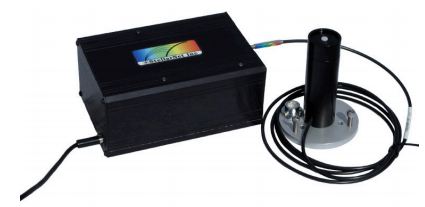
Spectroradiometers like this one can measure the light bands put out by LED grow lights. Unfortunately they cost around $5,000 making it difficult to test companies’ claims about their lights.
Nate: We’re seeing a trend in the industry where LED grow lights come out with more and more “bands” of light. Initially most of the LED lights were only two bands (red and blue). Now companies are starting to claim their lights have 11 bands and more. What are your thoughts on this? Is this marketing hype or is there something to this movement?
George: When it comes to the spectrum and the bands, it’s important to understand the basics. Enough research has been done to date to paint a good picture of how most plants use light. For example the chlorophyll a and chlorophyll b peaks at 430/470 and 620/660 nm are very well documented. The other thing you want to keep in mind is there is plenty of process variation in the manufacturing of LEDs. This means that if you buy a lot of say 450nm LEDs you’ll get some that peak at 440nm, others that peak at 460nm. So as much as the marketing hype coming out of some LED grow light companies leaves customers feeling that more bands is better this is not necessarily true. Our research has shown the following:
- The high absorbance spectral region of plants is between 420nm and 480nm in blue and 610-680nm in the red.
- It’s important to deliver some light in the 500-600nm range (green/yellow) targeting the carotenoids for good plant morphology
- Anything above 700nm can have a negative impact on plant growth
- Some UVB (280nm-315nm), can be helpful
- Light intensity and proper red/blue balance has a much higher impact on plant growth than specific bands.
We use 5 different LED spectra in our lights, plus UVB in the SolarStorm. We include warm white (3100K) to fill-in the spectrum between 500 and 600nm. On the SolarStorm we also have a switch to optimize the blue/red ratio for vegetative growth vs. bloom. Given the process variation in LEDs, when you look at the Spectro-radiometric chart of our lights, you’ll notice high coverage in the range between 420 and 480nm and 610-680nm and some coverage between 500 and 600nm.
Nate: I’m interested to hear more about your 120 degree diodes. During the past few years it seems like companies have been moving away from these wider diodes more towards 90 and 60 degree diodes. The argument is that the tighter beam angles allow for deeper penetration. Why are you going with the 120 degree diodes? Does it have something to do with the powerful 5w diodes you are using?
George: There is no free lunch Nate. When you use secondary optics (i.e. external lenses) to narrow the beam angle you do get a higher concentration of light in the center but you do that at the expense of coverage area at a given height. What’s worse, you immediately lose up to 10-15% of your light output when you use secondary optics. It’s simple light physics: Anytime light has to travel through another medium before reaching the plant leaves there’s a loss.
We have a fully equipped photometric lab with NIST traceable calibration at California LightWorks. That’s one of our key strengths. We studied all the beam angle options and chose to go with LED emitters that have 120 degree polished glass primary optics. Many low end LED emitters use gel-based primary optics and acrylic secondary optics which don’t transmit light as well and lose transparency over time.
With our 5W emitters, the light intensity is so high, even from a distance of 24” that any beam angle narrower than 120 degrees becomes overkill. Other companies need to use a narrower beam angle in order to get higher intensity at the longer distances. But of course they do that at the expense of coverage area.
Our SolarStorm is designed to cover a 4’ x 4’ area. We are very straightforward with our customers when it comes to the performance of our lights. In fact we openly share very detailed spectroradiometric measurement data with potential customers comparing our lights to HPS. Not many companies either have the ability or are willing to share this level of detailed data with their customers.
Nate: The Solar Flare doesn’t come with the UVB light correct? Is that just a matter of spacing and design? Why did you add UVB to the Storm but not the Flare?
George: That’s right Nate. It was simply impractical to fit fluorescent bulbs in the smaller SolarFlare units. In addition, the SolarFlare comes in three different spectral blends: FullCycle, VegMaster and BloomBooster. Each type is used differently in a grow room. The SolarFlare is a smaller, more flexible unit that can easily be used in conjunction with HID and supplemental UVB fluorescent lights.
Nate: Let’s end this off with a chance for you to tell us what separates your lights from the main competitors in the field. Name two or three things that distinguish your lights from the rest of the pack.
George: Our goal at California LightWorks is to bring the latest advances in solid state lighting technology to the everyday grower at affordable prices. Our current line of LED grow lights offer superior price-to-performance ratio compared to any of our competitors. And we continue to improve this ratio (both by improving performance and lowering costs) faster than anyone else in our industry because we are US based and we have R&D, manufacturing and sales all under one roof. If I were to name three things that distinguish our current product line from others I would say:
1) Clearly differentiated designs and features: All Chinese made grow lights look like they came out of the same factory. Our patented designs and unique features such as Veg/Bloom control, UVB (on the SolarStorm) and the super quite fan on the SolarFlare are non-existent elsewhere
2) Affordability: Our products are very competitively priced
3) Results: We are laser-focused on providing products that deliver results as shown by the SolarStorm Grower Feedback Program.
Again, a special thanks to George Mekhtarian, CEO of California LightWorks, for answering these questions for us today. If you have any other questions about the SolarStorm or the SolarFlare, leave a comment below and I’ll see what I can do for you.
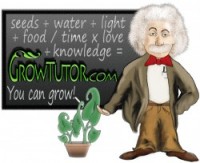

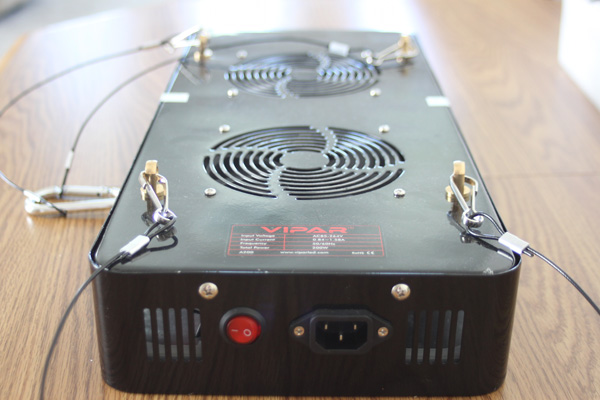
Looks do not justify the $2000 price tag this new solarstorm comes with. Neither does adding two $10 CFL’s , and neither does 5 watt LED’s . You can obtain same wavelength using 4 of the 90watt ufo style models and adding 2 UVB CFL’s. I can appreciate the smart talk but the only thing this has going for it is the looks. I can’t show it to anyone since, hello, who advertises their growroom? It would sit zipped up in a grow tent not on display showing off how cool it looks. The price tag is an insult to our intelligence and must solely be based on cosmetics.
Hey Jivaman,
First off I appreciate you stopping by the site.
I agree with you that $2,000 is a lot of money, but I’m not sure what you’re advocating here. Are you saying that you are better off buying four UFOs and hoping for the best? Most of the UFO lights on the market (not including ProSource’s UFOs) are not going to grow large plants. They simply lack the light power. If you want to a small sprout or something like that, then you can get away with using cheap UFOs that are under $100. If you want to grow something that requires a lot of light like Tomatoes or Medical Cannabis, then you are going to be completely wasting your money with cheap UFOs. Your plants will look great for the first couple of weeks and then they won’t flower at all!
As far as the price per watt goes, the SolarStorm and SolarFlare are on par (maybe even a bit better) with the industry leaders.
Hope that makes sense.
Best,
Nate
This is good news indeed. Great review!
First I was sold on HGL, but this makes for another checkup =)
Awh.. Looks like it is US shipping only :/
Nate! When can we expect to see the review of the Solarstorm light ?
After contacting California Lightworks, George Mekhtarian mailed me 00:13 AM telling me that they did not ship to Europe yet, but he recommended me Lumigrow as a optional LED grow company. Do you mind checking them out ?
My first glance at their website gave me the feeling of a very professional company with much good feedback.
I was thinking of buying the ES330, the price is costly, but it looks like they do quality, not quantity.
Glenn
Hey Glenn,
I’m in the process with my review of Lumigrow lights as well. Thanks for sharing that tidbit that George recommended them. That’s interesting indeed. The way these companies are always at each others’ throats I almost never see them say a nice thing about another company. haha
Nate
Hey Glenn,
I’m almost finished with it. My grow is in the early phases but I’ve almost completed my review of all the specs. Sorry to hear they couldn’t ship one to you!
Nate
Hey Nate, great interview! Have you posted your review on the SolarStorm yet?
Hey Christian,
I’m still waiting for my grow to finish. It’s looking pretty dang good! I might publish a review sooner though because I’ve been postponing it forever.
Sorry for the slow response on this. I’ll get it up within the next 7 days!
Nate
Hi Nate,
I love the detail and honesty of your reviews (regardless of the negative feedback you get from time to time). I posted a question in the polls and surveys area of your website which was in reference to the Lumigrow ES330, I am glad too see that you are planning on reviewing this light, do you have any preliminary results or thoughts on this light?
Hey Will,
My only preliminary thought is that I think it’s going to be a solid light. I had an expert in the industry who sells a light of his own tell me that the Lumigrow lights are good (that’s saying a lot because most of the people selling these lights don’t usually speak favorably of the competitors’s lights).
I’m eager to get my hands on one and hopefully will very soon.
Best,
Nate
“Our LEDs come from a Silicon Valley company that uses the latest low thermal resistance ceramic packaging technology …”
….
“But as production capacity for LEDs goes up around the world, I expect prices to come down.”
Why would silicon valley prices drop? Would they be ABLE to drop prices to compete or are you projecting a technology change? Price drops due to quantity alone could mean the silicon valley company stops producing or that you can’t afford to drop prices to compete unless you buy the cheaper foreign LEDs.
I guess I don’t understand the relationship you are positing.
Thanks.
bob